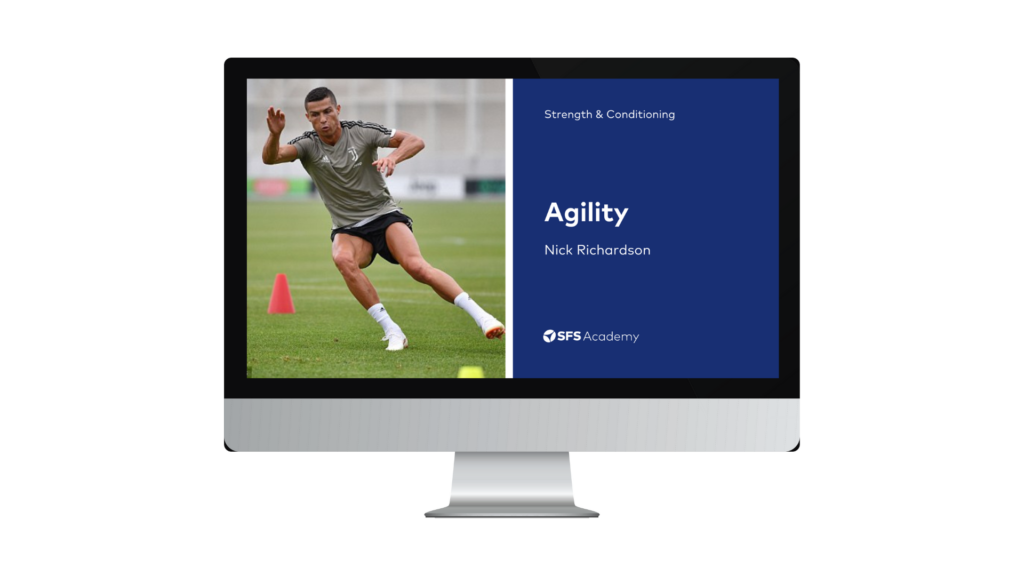Contents
- Introduction
- What is the NordBord?
- What are the origins of the NordBord?
- What does the NordBord measure?
- What tests can NordBord perform?
- How can NordBord support hamstring training?
- What is a good strength score for common NordBord tests?
- NordBord Normative Data Explained
- How can practitioners get the NordBord?
- Conclusion
VALD’s NordBord Hamstring Testing System has become the standard for field-based hamstring strength assessment, performance, injury risk management, and rehabilitation.
Recognised as the default choice for hamstring testing and training worldwide, the NordBord combines precision, portability, and powerful data analytics to support practitioners in assessing, tracking, and building hamstring strength.
Trusted by thousands of teams and organisations globally – including the National Football League (NFL), National Basketball League (NBA), Major League Baseball (MLB), and English Premier League (EPL) – NordBord’s evidence-based approach has made it an indispensable tool in high-performance sports, rehabilitation, and research. With millions of assessments conducted on the NordBord annually, it has become a critical component in managing hamstring injury risk, enhancing performance, and maximising athlete resilience.
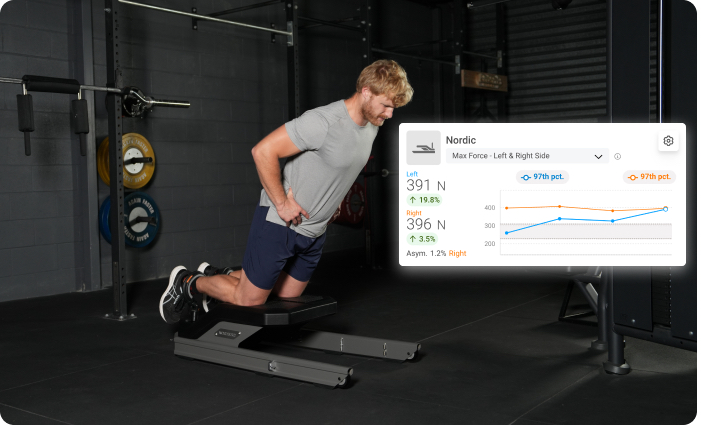
What is the NordBord?
The NordBord is a hamstring testing system that provides precise assessments of strength and asymmetry. Its durable design and high-accuracy load cells make it a reliable tool for practitioners working in clinics, gyms, and performance centres.

With ergonomic knee pads for comfort and accurate positioning, the NordBord captures both eccentric and isometric hamstring strength in real time. This data helps practitioners identify asymmetries, track progress, and refine training or rehabilitation strategies with confidence.
The NordBord app provides real-time feedback during tests and supports custom protocols that can be tailored to each athlete’s needs. Integration with VALD Hub ensures that all data is centralised for long-term tracking, comparative analysis, and actionable insights. Whether for a single athlete or an entire team, NordBord delivers the tools practitioners need to enhance performance and reduce injury risks.

Below are the key technical specifications for the NordBord:
 | |
| Features and Specifications |  |
| Weight | 19 kg (42 lb) |
| Size | 1,203 mm (47.3 in) L x 639 mm (25.1 in) W x 437 mm (17.2 in) H |
| Load Capacity | 2,000 N / 200 kg / 440 lb |
| Sampling Rate | 50 Hz (default) – 400 Hz |
| Battery Capacity | 100 hours of active use |
| Wireless Communication | Bluetooth 5 |
For a detailed breakdown, you can access the full NordBord technical specifications here.
What are the origins of the NordBord?
The NordBord was invented by Dr Anthony Shield and Dr David Opar at the Queensland University of Technology (QUT). The NordBord was developed for portable, accurate hamstring strength testing to enable research on the effects of eccentric strength and asymmetry in hamstring strain injury (HSI) risk.
They invented the NordBord to allow practitioners to test both legs independently and simultaneously to obtain accurate asymmetry measurements ‒ a key indicator of HSI risk – in the field.
Since its release, NordBord has become a cornerstone of modern hamstring strength testing, backed by dozens of peer-reviewed papers and trusted by practitioners worldwide to enhance performance, reduce injury risks, and aid recovery.
What does the NordBord measure?
The NordBord focuses on three key metrics:
- Force (N): Measured directly by NordBord’s load cell sensors, force represents the amount of effort exerted by the hamstrings during contraction. This data is captured in real time, giving practitioners immediate insights into muscle strength.
- Torque (Nm): Torque, or rotational force, is calculated as the product of force and length. For the NordBord, length refers to the distance between the knee joint centre and the NordBord ankle hooks. This distance is estimated using the knee position setting, enabling accurate torque measurement to assess rotational strength.
- Impulse (Ns): Impulse measures the total “work” performed by the hamstrings, calculated as the area under the force-time curve. This metric reflects the ability to sustain force over time. Impulse thresholds are applied to filter out unwanted contractions, ensuring only meaningful data is included in the results.
These metrics enable practitioners to analyse hamstring strength across various contraction types while also detecting any asymmetries. This provides a well-rounded profile of hamstring health and performance capacity, helping practitioners address strength deficits, mitigate injury risks, and optimise performance strategies.
What tests can NordBord perform?
The NordBord offers a range of test types designed to capture different aspects of hamstring strength and asymmetry:
| Test Types | Description | Contraction Mode | Rep Detection |
| Nordic | Nordic hamstring curl | Eccentric | Bilateral |
| Razor | Razor hamstring curl | Eccentric/Isometric | Bilateral |
| ISO Prone (0°) | Isometric hamstring contraction in the prone position | Isometric | Unilateral |
| ISO 30° | Isometric hamstring contraction with knees at 30° of flexion | Isometric | Unilateral |
| ISO 60° | Isometric hamstring contraction with knees at 60° of flexion | Isometric | Unilateral |
| Custom | Custom test, e.g., Single-Leg Nordic | – | – |
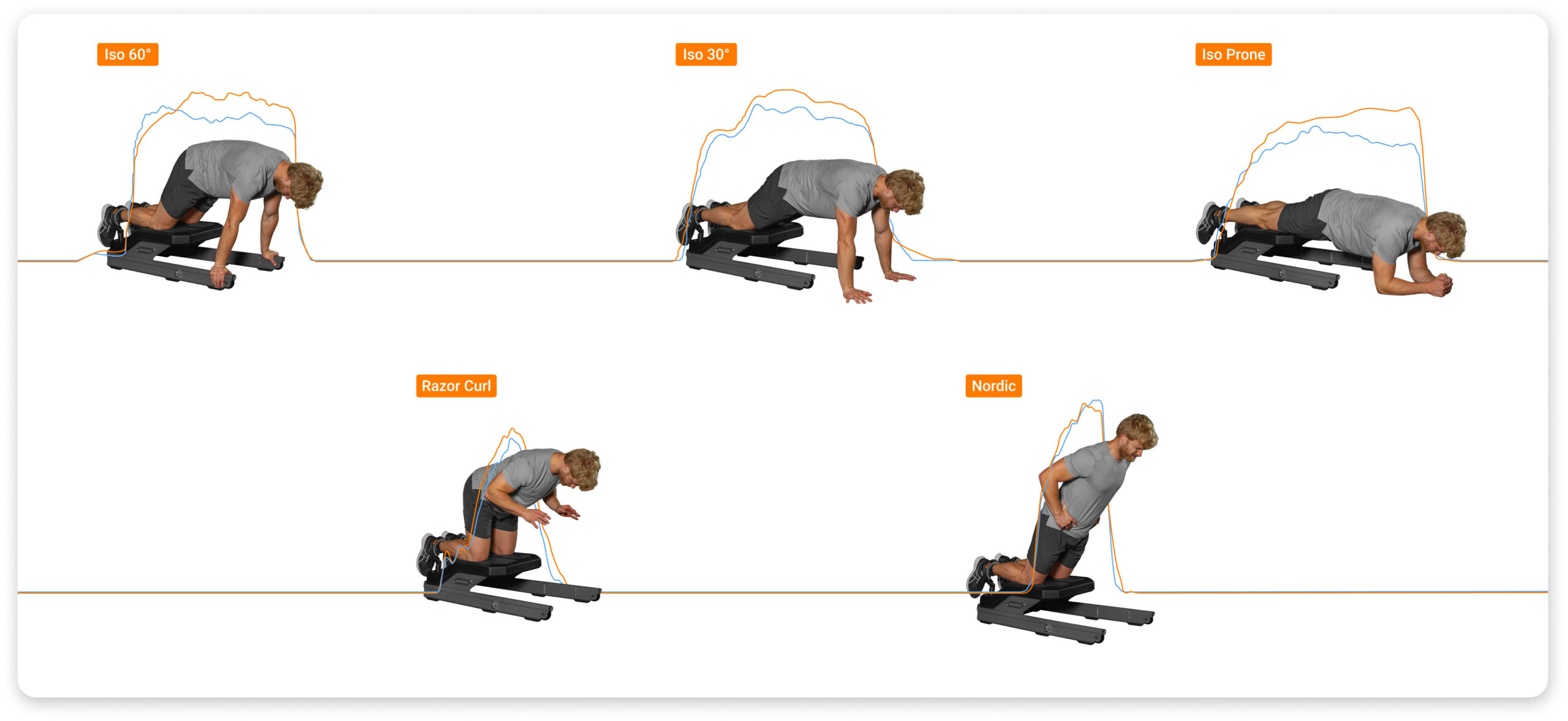
These test types can be utilised at various stages of recovery or performance assessment, providing valuable insights for individualised training and rehabilitation strategies.
How can NordBord support hamstring training?
In addition to testing, NordBord is also a valuable tool for hamstring strength training, offering both isometric and eccentric Training Modes. The NordBord app enables practitioners to set up customised programmes by defining parameters such as contraction times, target zones, training thresholds, repetitions, and rest periods, which can be set in relation to previous test scores (e.g., a percentage of maximum voluntary contraction (MVC)).
This capability supports progressive overload and targeted training, helping athletes develop the strength needed to reduce injury risks and improve performance. Such individualised training programmes are particularly useful for athletes recovering from hamstring injuries or aiming to optimise performance in high-demand sports.
What is a good strength score for common NordBord tests?
As with all physical tests, the definition of a “good” strength score on NordBord varies wildly depending on an athlete’s age, gender, sport, and fitness level.
Practitioners can utilise NordBord’s Norms, both in-app and in VALD Hub, to benchmark individual results against population averages. These Norms enable the identification of strengths and weaknesses, the setting of realistic goals, and the tracking of progress over time.

VALD’s Norms are based on tens of millions of tests from millions of anonymised individuals, allowing practitioners to make evidence-based decisions and deliver tailored support for athletes at any stage of their training or rehabilitation.
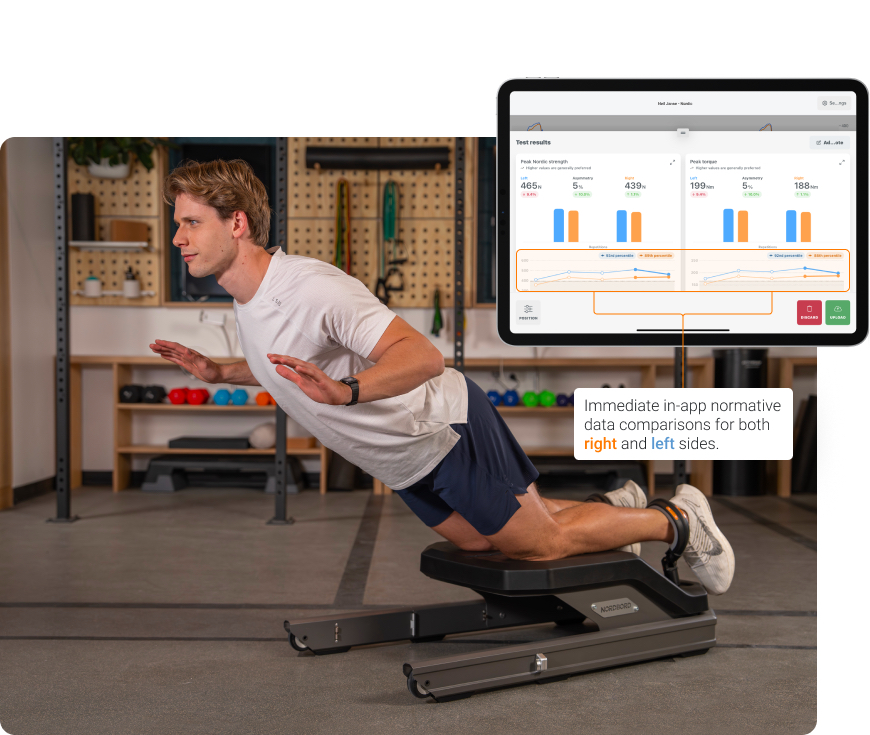
NordBord Normative Data Explained
Beyond integrated Norms, VALD also offers a range of sport- and population-specific normative data reports embedded in VALD Hub to provide additional context to coaches and athletes.
VALD’s normative data reports are derived from large datasets across sports like track and field, soccer, and basketball. These reports offer practitioners valuable benchmarks to:
- Compare individual athlete performance against sport-specific norms.
- Identify asymmetries or deficits that may impact performance or increase injury risk.
- Track improvements over time and refine training programmes based on data-driven insights.
Examples of normative data reports:
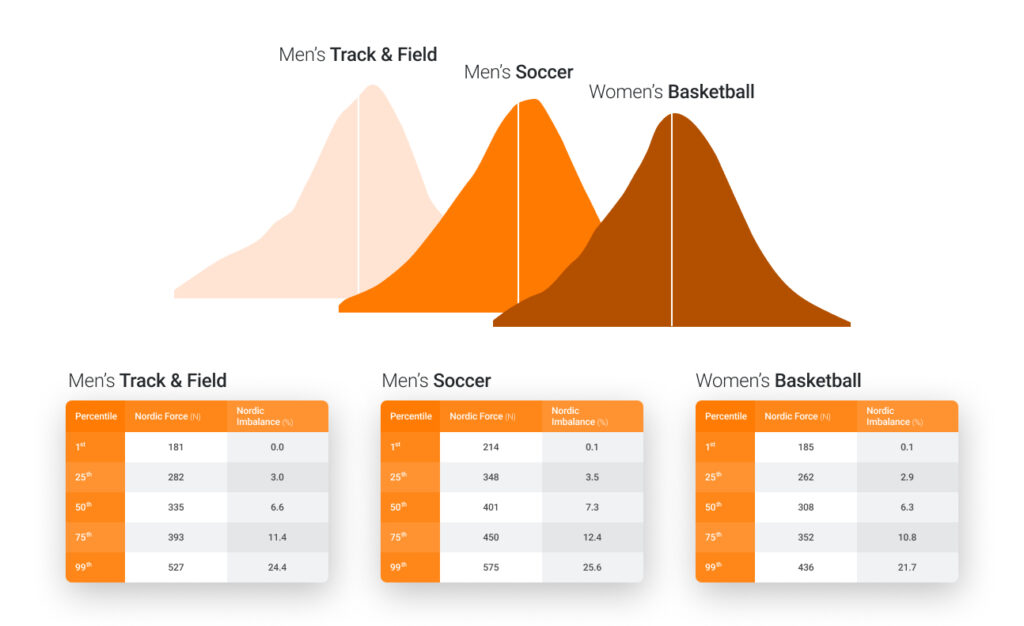
By using these normative data reports as reference points for training and assessments, practitioners can ensure that programmes are both individualised and evidence-based, improving outcomes in both performance and rehabilitation.
How can practitioners get the NordBord?
VALD operates on a subscription-based pricing model that ensures continuous access to the latest innovations and unlimited support. This all-inclusive plan covers unlimited software updates, feature releases, and a comprehensive warranty for repairs and replacements at no extra cost.
Practitioners can subscribe to NordBord by reaching out to VALD’s team of Business Development Managers (BDMs) and Client Success Managers (CSMs), most of whom are performance or health practitioners themselves.
VALD’s team provides personalised support and expert guidance throughout your onboarding and implementation process, as well as ongoing learning and development. VALD’s team prides itself on respecting clients’ decisions and ensuring you derive maximum value from your NordBord.
Conclusion
VALD’s NordBord has become the gold standard for field-based hamstring strength testing and training. Its ability to measure key performance metrics, combined with isometric and eccentric training features, makes it the go-to tool for field-based hamstring performance assessment and injury management.
To learn more about NordBord, get in touch with VALD via email or follow us on social media: X, LinkedIn, Instagram, and YouTube.

